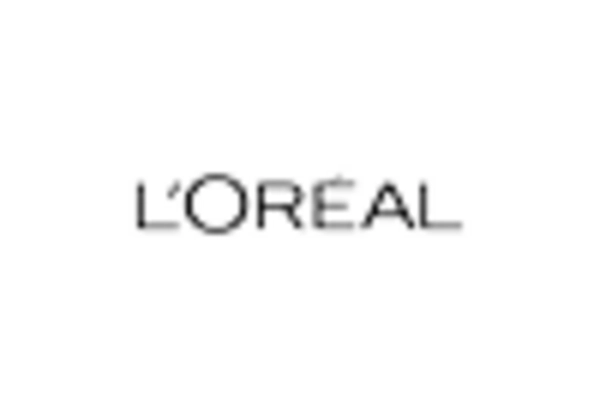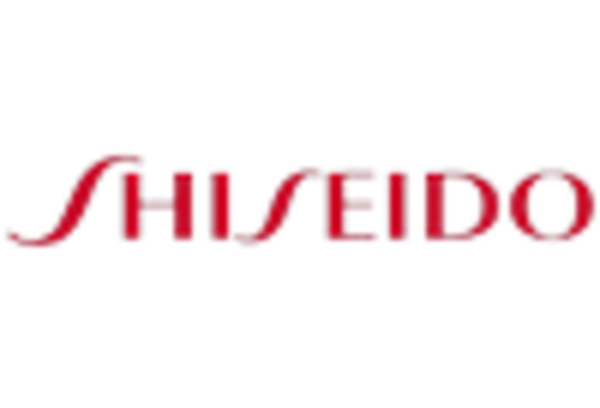Rise of E-commerce in Cosmetic Products Industry
The Cosmetic Products Industry is experiencing a notable shift towards e-commerce platforms, which appears to be reshaping consumer purchasing behaviors. As of 2025, online sales account for a substantial portion of total cosmetic sales, driven by convenience and a wider product selection. This trend is further fueled by the increasing penetration of smartphones and internet access, allowing consumers to shop from anywhere. Additionally, social media marketing plays a pivotal role in influencing purchasing decisions, with beauty influencers and user-generated content driving engagement. The ease of access to product reviews and comparisons online enhances consumer confidence, potentially leading to higher conversion rates. As e-commerce continues to expand, traditional retail channels may need to adapt to maintain competitiveness in the Cosmetic Products Industry.
Focus on Inclusivity in Cosmetic Products Industry
The Cosmetic Products Industry is increasingly prioritizing inclusivity, reflecting a broader societal shift towards diversity and representation. Brands are expanding their product lines to cater to a wider range of skin tones, types, and preferences, which appears to resonate with consumers seeking authenticity and relatability. Market Research Future indicates that inclusive brands often enjoy stronger customer loyalty and higher sales, as they address the needs of underrepresented demographics. Furthermore, campaigns that celebrate diversity not only enhance brand image but also foster a sense of belonging among consumers. As inclusivity becomes a standard expectation rather than an exception, brands that fail to adapt may find themselves at a disadvantage in the competitive landscape of the Cosmetic Products Industry.
Influence of Social Media on Cosmetic Products Industry
The impact of social media on the Cosmetic Products Industry cannot be overstated. Platforms such as Instagram, TikTok, and YouTube serve as powerful marketing tools, where beauty trends can go viral overnight. Influencers and beauty gurus have become key opinion leaders, shaping consumer perceptions and driving sales through authentic content. Market data suggests that brands leveraging social media effectively can achieve higher engagement rates and brand loyalty. Additionally, user-generated content fosters a sense of community among consumers, encouraging them to share their experiences and recommendations. This dynamic interaction between brands and consumers is likely to continue influencing purchasing decisions and brand strategies in the Cosmetic Products Industry.
Technological Advancements in Cosmetic Products Industry
Technological innovations are playing a crucial role in the evolution of the Cosmetic Products Industry. Advancements in formulation science, such as the development of new delivery systems and active ingredients, are enhancing product efficacy and consumer satisfaction. Moreover, the rise of augmented reality (AR) and virtual try-on technologies is transforming the shopping experience, allowing consumers to visualize products before purchase. This integration of technology not only improves customer engagement but also reduces return rates, which can be a significant cost for retailers. Furthermore, data analytics is enabling brands to better understand consumer preferences and tailor their offerings accordingly. As technology continues to advance, it is likely to drive further growth and innovation within the Cosmetic Products Industry.
Growing Demand for Natural Ingredients in Cosmetic Products Industry
There is a discernible trend towards natural and organic ingredients within the Cosmetic Products Industry, as consumers become increasingly health-conscious and environmentally aware. This shift is reflected in market data, indicating that products labeled as 'natural' or 'organic' are witnessing accelerated growth rates, often outpacing conventional products. Consumers are seeking transparency regarding ingredient sourcing and formulation, which has prompted brands to reformulate existing products to align with these preferences. The demand for clean beauty products is not merely a passing fad; it appears to be a fundamental change in consumer expectations. As a result, companies that prioritize natural ingredients may find themselves at a competitive advantage in the Cosmetic Products Industry.

















Leave a Comment